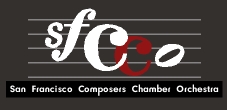Sturm und Drang und SFCCO |
| JEFF KALISS |
||||||
|
San Francisco Composers Chamber Orchestra, conducted by Mark Alburger and John Kendall Bailey, in Sound for Picture: Harry Bernstein's Chamber Set; Alburger's Suite ("Sol[ar]") for Oboe, Piano, and Percussion; Philip Freihofner's Quartet, Lisa Scola Prosek's Leonardo's Notebooks, Alexis Alrich's Flute Concerto, and Loren Jones's Dancing on the Brink of the World. March 10, Old First Presbyterian Church, San Francisco, CA. The climate was a hard act to follow on the evening of March 10, when the skies over San Francisco thundered while the streets below were spread with an unaccustomed covering of tenacious hailstones. But delightful and somewhat unfamiliar discoveries also awaited those who made their careful way to the woody warmth of Old First Presbyterian Church. There, under the musical directorship of Mark Alburger, the San Francisco Composers Chamber Orchestra showcased the compositions of six of its members in a program titled Sound for Picture providing even more variety and surprises than the recent weather. The opening Chamber Set, by Harry Bernstein, evoked some gentler aspects of nature, in the process of Bernstein's explorations of instrumental color. These pieces, all written within the past three years, served in part to showcase Bernstein's interest as a flautist in the rarely featured alto flute. The instrument was partnered in friendly manner in a Duo by its string cousin, the viola, and by two other altos in the lustrous tone clusters of a "Color Study." (As with others of the evening's featured artists, Bernstein functioned, on the latter composition, as instrumentalist as well as composer.) A "Duet for Zack," written for a Marin County middle school student, was set as a querulous, sometimes funny dialogue between oboe and soprano sax. "If All the World Was Apple Pie" was all strings, two violins and a viola, in a dreamy confection artfully performed. In his familiar and infectious role of showman, Alburger provided in the program notes a daunting list of the influences, not all of them classical on his Suite ("Sol[ar]") for Oboe, Piano, and Percussion. Most obvious to the ear were minimalist narrow modalities and repeated figures, meant to convey the listener on a quick voyage from our sun through its planets. Our own "Earth" emerged as the most lucid portion of the system, while neighboring "Venus" appeared oddly troubled. Philip Freihofner, who'd played oboe on Alburger's trip, stayed on in his own Quartet with clarinet, French horn, and bassoon, originally conceived as part of a score for a 1926 Russian silent film. An opening "Galop" proved a crowd-pleaser, the tight ensemble playing elevated by a Prokofievian levity. Freihofner cleaved closer to traditional compositional forms than had Bernstein or Alburger, but with endearing twists in a ticklish "Waltz," a triste "Fugue," and a folksy "March." Lisa Scola Prosek presented a scene from her opera Leonardo's Notebooks, which will be premiered in its entirety by Harriet March Page's Goat Hall Productions at Thick House on May 18. Three fine vocalists sang in Italian about what Prosek pre-announced as a matter of Da Vinci's measurement of shadows and the Catholic Church's suspicions about his research. The setting was dramatic, though not particularly lyrically memorable, set against monumental recurring instrumental patterns. The result was variously evocative of Philip Glass's film score for Koyaanisqatsi and the theatrical declamations of Andrew Lloyd-Webber. Alexis Alrich, who shared the evening's pianistic duties with Prosek, announced the featured selection from her own Flute Concerto as "a combination of sophistication and primitivism." Alrich's composition was commissioned by and in large part performed by virtuoso flautist Ilse Maier, partnered by Gabriel Sakakeeny's large drum. "Sophistication" was particularly evident in one of the evening's best and most attractive arrays of the colors of the chamber orchestra. Alburger helped elicit "primitivism" through his contributions on percussion, including hand-claps, and there was an appealingly ethnic effect to the arrangement, at times Latin, at times Asian. Even closer to American folk and world music was Loren Jones's Dancing on the Brink of the World, four parts of what will ultimately be a 12-ection musical diorama of four centuries of San Francisco history. The composer played an end-blown Native American flute for the lovely opening "Ohlone Song," homage to some of the original native inhabitants of the San Francisco Bay Area. The ensuing "Ave Maria Yerba Buena," marking the arrival of Spanish-speaking Catholic missionaries, was sweetly inspiring to both audience and chamber players, handsomely passing a memorable them from strings to horns to harp and guitar. Alburger's characteristically kinetic and passionate approach to conducting was effectively applied here. The "Gold Rush" made clever use of banjo and guitar, though not with as impressive a range of motion as in the previous section. Similarly, the "Dragon Gate" represented the mid-19th-century presence of Chinese immigrants by integrating an erhu fiddle and the plucked pipa into the chamber orchestra, but the effect was rather more charming, in a filmic soundtrack sense, than orchestrally impressive. Alburger and his talented cohorts succeeded admirably in warming their audience to the under realized potential of what's referred to as New Music. As the year moves on, we eagerly await the completion of those works-in-progress, which were introduced at Old First and more such marvelous variety shows. +++JEFF KALISS writes on music and theatre for Commuter Times, San Francisco Chronicle, and 20TH-CENTURY MUSIC. A version of the present review first appeared in Commuter Times. This edition appears in the May 2006 issue of 21ST-CENTURY MUSIC
|
||||||
 |
